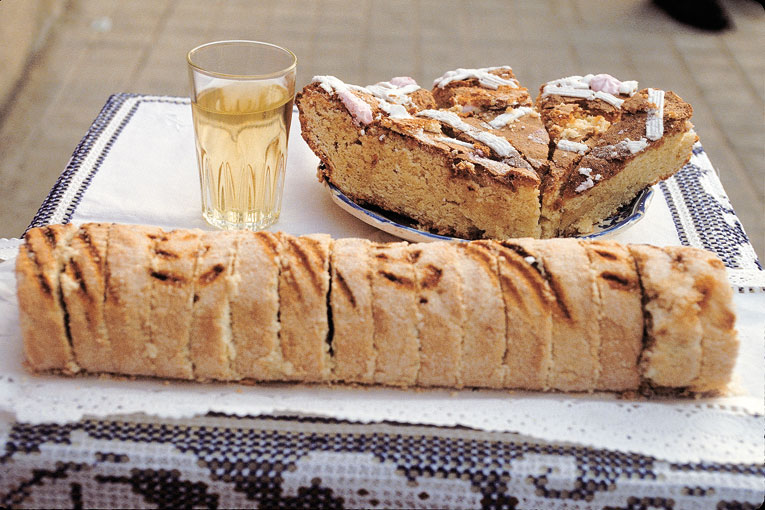
Food plays a major role in the traditional calendar, and many festivals are inextricably linked to food-related customs. The culinary heritage of the Piedmont region of Italy is currently subject to reassessment and reinterpretation, at the service of creative logic, which is proposing to overcome the economic crisis by recovering traditional savoir faire. There are movements within this school of thought, like Slow Food and initiatives such as those taken by the University of Gastronomic Sciences, which has made a survey on the role of food in festivals. |
||
|
An anthropological principle maintained from many points of view is that festivals, rituals and folk traditions, form part of the revival of a community. A community is understood as a realm where collective memory is still shared practice and a means to build identity, representing the people, enabling the individual to survive within this shared knowledge, even after death. However, less widely accepted is the role food plays in ritual celebrations, forming part of the paraphernalia accompanying a community festival, an essential element of belonging, which is socially and culturally rooted. Here I propose to show, therefore, that food plays an important role in the events on the traditional calendar. Nowadays in particular, the gastronomic component that feeds and nourishes rituals sets the pace that best defines them, and currently ensures continuity and guarantees survival, if not recovery, of our traditions. In this context food is not just a cultural trait, essential to secure and define postmodernism, but also a proactive element of the new economy, of which food is a significant part. I have been able to follow this line of study thanks to a research project I have been working on for decades, which aims to provide an analytical overview of the festivals that have marked the agrarian history of Piedmont and actively characterise this territory today (Grimaldi, 1993, 1996; Grimaldi and Nattino, 2009). The region represents an excellent laboratory to gain an understanding of many of the recent industrial achievements and contemporary postmodern developments in Italy, and to interpret the historical and future traits of Western development in its maturity, that is, late modernity (Ariño and Lombardi Satriani, 1997). |
«Food plays a major role in the events highlighted on the traditional calendar» |
|
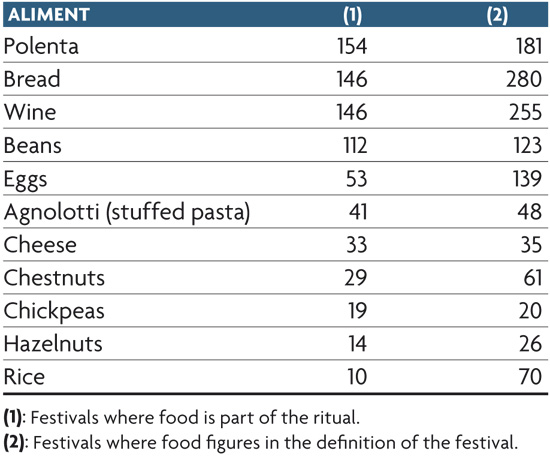 Mètode MètodeThis table shows the foods most often consumed during Piedmont festivals. In this region of Italy, polenta is considered one of the main culinary ethnic features, as shown. |
«For several years the University of Gastronomic Sciences and of Eastern Piedmont have been undertaking a complex project to make an inventory of all the popular festivals on the calendar of the Piedmont region» |
|
|
From agriculture to gastronomy, through industry Piedmont is an important region defining north-western Italy. In the nineteenth century it was agricultural land, while the twentieth century was marked by strong industrial development, especially in the engineering sector. Fiat, the Italian automobile industry, was born and bred in Turin, where it led and shaped the culture and economy of the entire region. Only during recent decades has the relentless decline of the company, dragging down with it ancillary trade related to the automobile industry, released the region from this production-driven constraint and fostered economic and cultural development that has largely opened up prospects offered by the food industry in particular. A clear example of this shift is the reconversion that Turin, the regional capital, has undergone. In the last twenty years, it has transformed from the industrial city it was, to become a metropolis that pays special attention to capturing a tertiary sector based primarily on the production and reappraisal of cultural heritage, in particular that related to the local cuisine and the wine sector. In short, the city projects a future of tourism, helped along by the wonderful rural landscapes surrounding it. This transformation that Piedmont has undergone is unprecedented in many ways and not necessarily predictable; a path whose deeper rationale lies in individual, subjective and self-generated skill engendered by the great entrepreneurial endeavour of individual people. Only at a later stage did this unforeseeable economic process receive significant support from national and local governments, which by definition should guide and project sustainable future scenarios that an individual alone is unable to cope with. Furthermore, all things considered, it is the subjective ability to sense and understand the future which has driven this process that, straddling the millennium, not only corresponds to a new production model built on small and medium-sized enterprises, be they artisanal or not, but is an example of an unprecedented novel experience that this process anticipated some decades ago. This is the recommencement of invention –or rather of reinvention– the resurgence of popular culture. Traditional knowledge, thought to be dying out due to the preponderance of industry, especially in conjunction with agricultural dispersion in the decades after the last war, has risen again to become a main player in the latest model of development. In other words, not only has the foretold demise of knowledge linked to tradition, in general, and to the rural world in particular, not been fulfilled but, in a few decades, what started as a timid resurgence of interest in the past –little more than a twinge of nostalgia in the seventies– has been gathering momentum to become the cultural phenomenon that has largely characterised the social and economic changes in the region over the last twenty years (Bravo, 1984; 2005). |
|
|
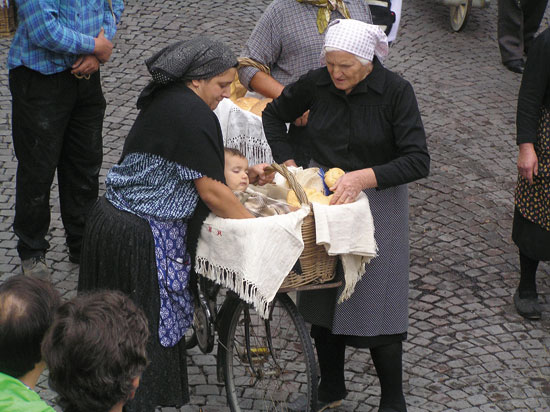 Antonio Ariño Antonio AriñoIn festive contexts, food can act as a means of reviving regions that may have been negatively affected by the consequences of modernisation. The images show the Festival delle Sagri, Asti (Italy). |
«Slow Food is undoubtedly the player that best represents this renewed interest in Piedmontese cuisine and rural tradition» |
|
|
Reinterpreting tradition The ability to rediscover and find new meaning in traditional knowledge related to food has been of particular importance in this scenario of change. This path is emblematically represented and interpreted by an associative adventure, also a constituent part of the laboratory region, arising towards the end of the last century in rural southern Piedmont and which was soon to become a cultural project of international impact. For one thing, the Slow Food movement arose from the cultural and manufacturing trends discussed above, and secondly, on a par, there were the players who drove this new direction, who would eventually reach a cognitive, cultural and economic horizon that left the political class in the backwoods as they continued to stagnate in old models of industrial development. One idea was developed by a group of friends –who remain so today– who had a lot of free time and (without knowing it yet) played out the creative leisure theory developed by sociologist Domenico De Masi (2000). Following the creation and empirical development of the Slow Food concept are Langhe hills, a land recreated by Pavese and Fenoglio. As the founder of this movement, Carlo Petrini (2001), recalls, it was in the taverns of the Piedmont region where his best ideas were born: places where good practices of a community continue to find a home and where traditional cuisine, which can only result from gesture and word, is renewed and transformed, passed down from mothers to daughters, aunts to nieces, to become not only a reproductive element but a deeply emotional one, able to nurture the tangible and intangible desires of a community. It was in this «community school» where the partnership, whose practices anticipated the theory, was formed, thus laying the foundations of the original gastronomic trend, which has more recently generated rich interpretive categories like «good, clean and fair» (Petrini, 2005 ). This is a philosophy and course of action that has discovered creative elements for economic development in the recovery, reinterpretation and resystematisation of traditional culinary heritage (Petrini, 2009). Thus, Slow Food is undoubtedly the player that best represents this renewed interest in the world of Piedmontese cuisine and rural tradition. Commitment has led to the recovery and acclaim of the potential of this region’s heritage, developing and guiding profitable processes of cultural and economic growth through the integrated revival of biodiversity and ethnodiversity. Within the framework of this new theoretical and empirical vision represented by Slow Food, the last decade has witnessed the creation, right here in its home territory, of the first university college in the world dedicated to gastronomic sciences. This is another indicator of excellence in this laboratory region. Not only does it represent the development of the region itself, but also the future of a vast world that is more or less mature in the productive sense, whose foundations lie in sustainable development and in the field of nutrition explicitly, as well as in a creative and affective logic that helps us overcome the economic crisis. |
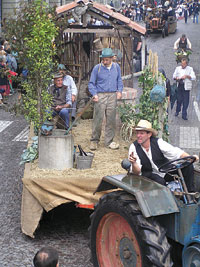 Antonio Ariño Antonio Ariño |
|
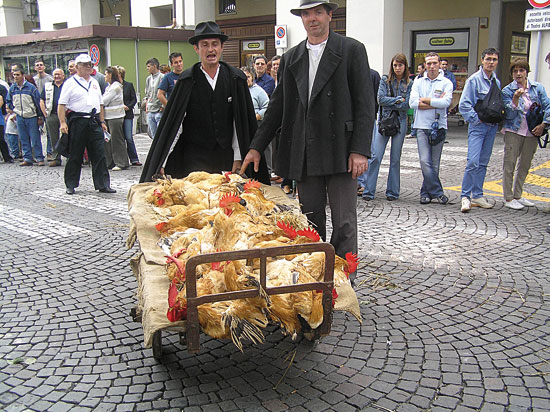 Antonio Ariño Antonio Ariño |
«The regional calendar of festivals renews and reinvents itself on a popular traditional and constant basis. Food is an important ethnic feature of contemporary festive heritage» | |
|
A universe of products The working hypothesis, confirming that Slow Food’s ways and practices are an interpretive expression of this new path of development, can be verified empirically in the light of some critical approaches that numerous ethno-anthropological investigations have documented using different methods in recent decades. This knowledge context enables us to better understand the profile of the traditional Piedmontese cuisine, a universe of products and symbols that are fully expressed during festivals (Grimaldi, 2012). For several years now, the University of Gastronomic Sciences and of Eastern Piedmont have been undertaking a complex project to make an inventory of all the popular festivals on the calendar of the Piedmont region: Atlante delle Feste Popolari del Piemonte. This atlas is a multimedia tool, available online, which allows for a critical reading of the ritual heritage of the region, connecting ethno-anthropological data with morphological and historical information, and social and personal data. First, the study is «mapped» onto the region, documenting the festive seasons and their variations over the course of the years, and therefore the changes, the reinvention processes, refunctionalisation of traditional knowledge. Furthermore, it employs a computerised system capable of critically restoring intangible cultural heritage in the territory, which until recently was essentially only represented in writing, while the latest technology resources provide a support not only for texts but also, and above all, for filing systems that bring written information alive through appropriate audiovisual material. Given this multimedia form, Atlante is presented as a vast archive of files, currently numbering 2,654, covering the 1,206 municipalities forming the Piedmont region, each of which describes a festival witnessed through written descriptions, photographs, videos and sound files (Porporato, 2007; 2010). The festivals on the inventory represent practically homogeneous distribution throughout the region of study, which shows that the research was carried out in a systematic and organised way. Regarding the presence of food within this festive framework, we find –as expected– that the existence of some traditional foods can help us to better interpret the ceremonial vein. Polenta, in fact, is considered one of the major ethnic culinary dishes characteristic of the region, and this dish is the most common in festive rituals (Grimaldi, 2012). In Piedmont’s collective imagination, polenta has strong associations with the alpine culinary landscape; however, if we analyse its distribution in Piedmont using Atlante, the cartographic interpretation shows us it is not distributed uniformly in the Alpine region, but rather characterises the plains. Of particular interest is the spatial distribution of celebrations linked to the use of eggs, quintessential ritual fare. The map leads us to the hills of southern Piedmont, where the practice of food exchange or barter has undergone a major revival and refunctionalisation, paying witness to the recovery of traditional culinary knowledge, focus of this study (Grimaldi, 2012). Festivals and food in times of crisis The information analysed confirms the vitality and richness of traditional ritual systems. The regional calendar of festivals renews and reinvents itself on a popular traditional and constant basis. Food –the culinary system–, as indicated by the first data examined, is an important ethnic feature of contemporary festive heritage. In the «revolution» analysed here, cultural to begin with and productive after, there are interesting logical and emotional reasons, in which food represents an important part, for the documented revival of festivals. In short, traditional cuisine can be understood graphically as a «symbolic emotion» that animates, as Cesare Pavese would have it, this new horizon, characterised at heart by a profound «legendary work» (2002). A path which, in times of economic crisis, is worth investigating further and understanding better, and also provides pleasure from creatively combining the two folk phenomena analysed, which are not just important in the context of the current situation –as we have tried to show– but also in shedding light on mankind’s evolutionary process: festivals and food, of course. Piercarlo Grimaldi. Professor of Cultural Anthropology. University of Gastronomic Sciences, Pollenzo (Italy). |
||
REFERENCES
Ariño, A. and L. M. Lombardi Satriani (eds.), 1997. L’utopia di Dioniso. Festa fra tradizione e modernità. Meltemi. Rome.
Bravo, G. L., 1984. Festa contadina e società complessa. Angeli. Milan.
Bravo, G. L., 2005. La complessità della tradizione. Festa, museo e ricerca antropologica, supervised by Laura Bonato and Piercarlo Grimaldi. Angeli. Milan.
De Masi, D., 2000. Ozio creativo. Rizzoli. Milan.
Grimaldi, P., 1993. Il calendario rituale contadino. Il tempo della festa e del lavoro fra tradizione e complessità sociale. Angeli. Milan.
Grimaldi, P., 1996. Tempi grassi, tempi magri. Percorsi etnografici. Omega. Turin.
Grimaldi, P., 2012. Cibo e rito. Il gesto e la parola nell’alimentazione tradizionale. Sellerio. Palermo.
Grimaldi, P. and L. Nattino (eds.), 2009. Il teatro della vita: le feste tradizionali in Piemonte. Omega. Turin.





